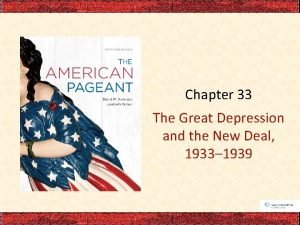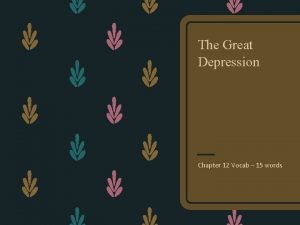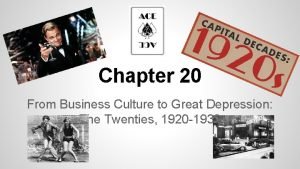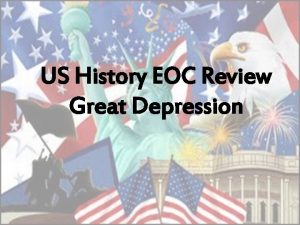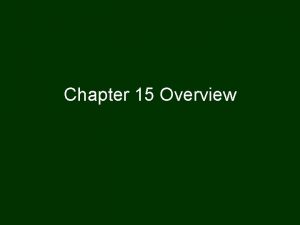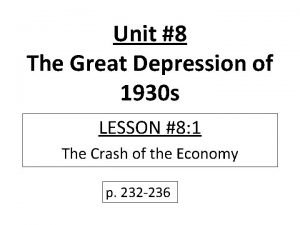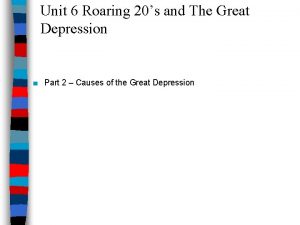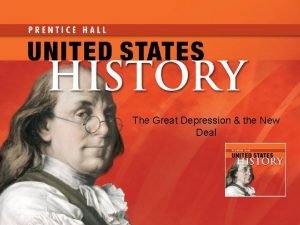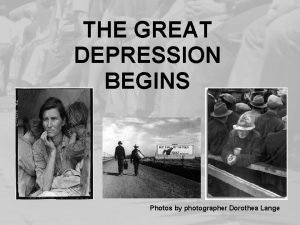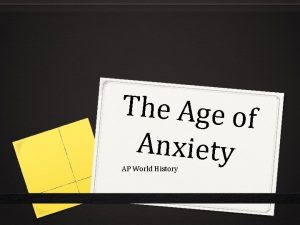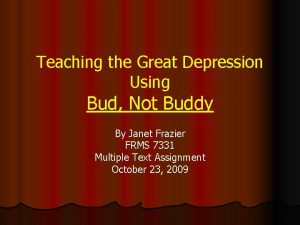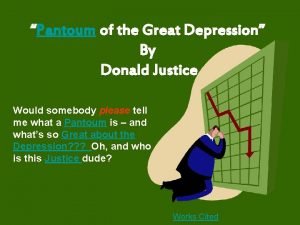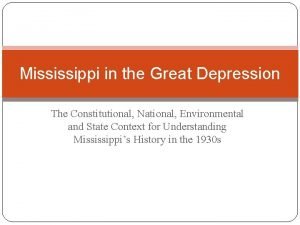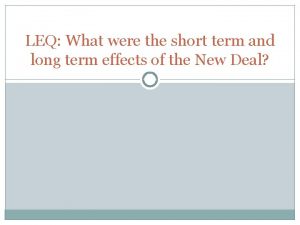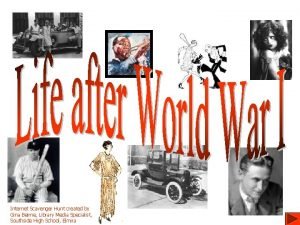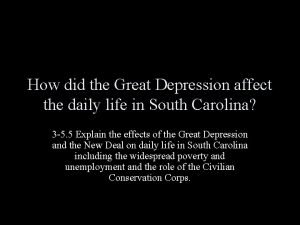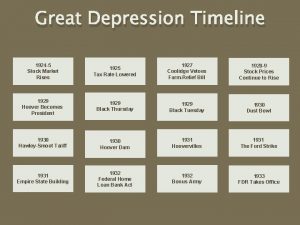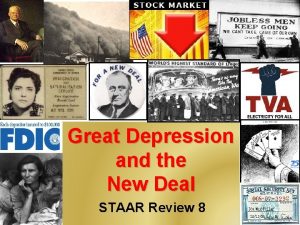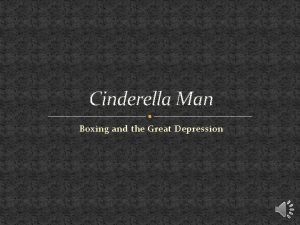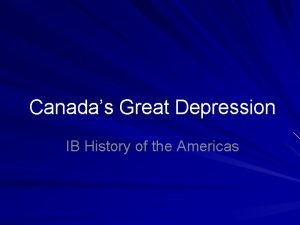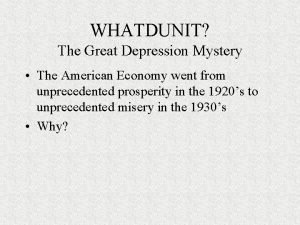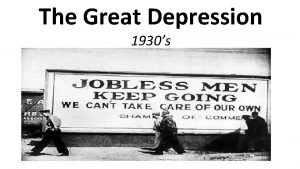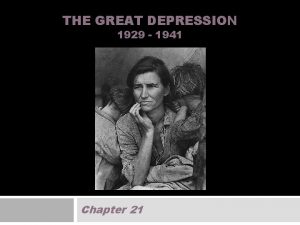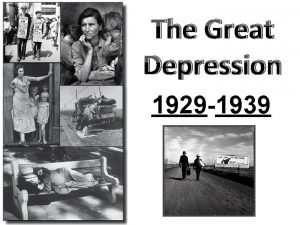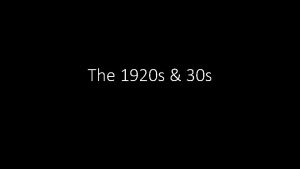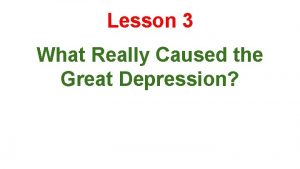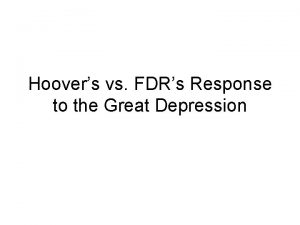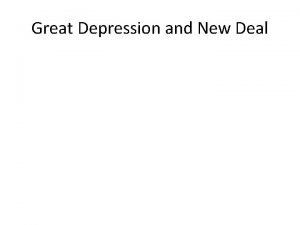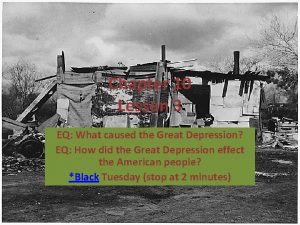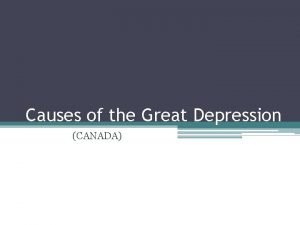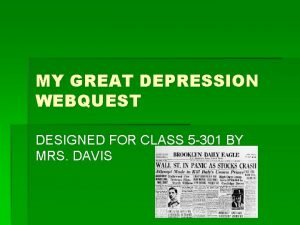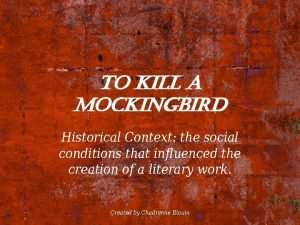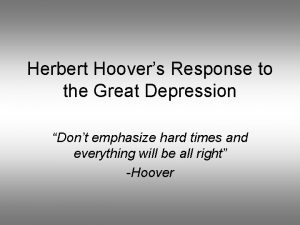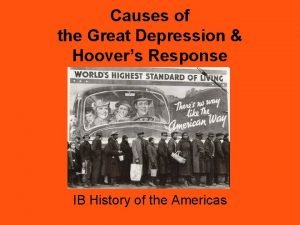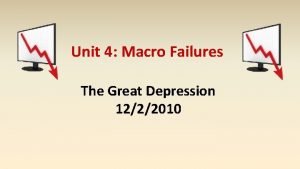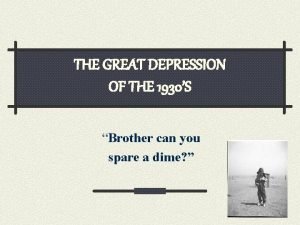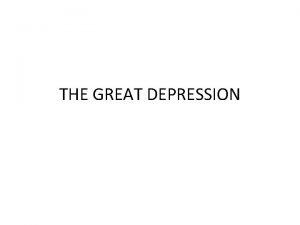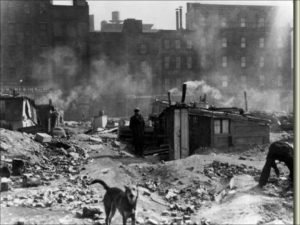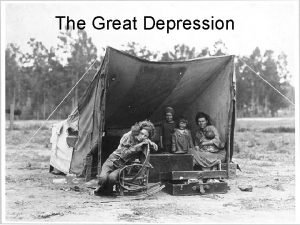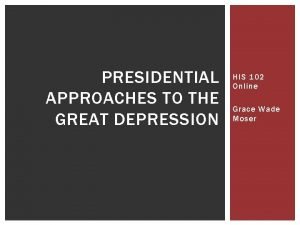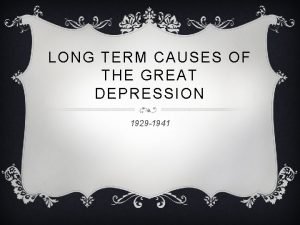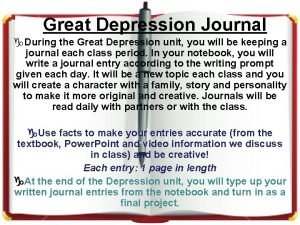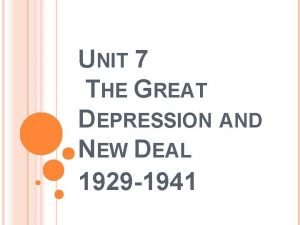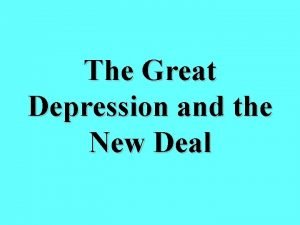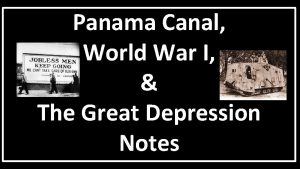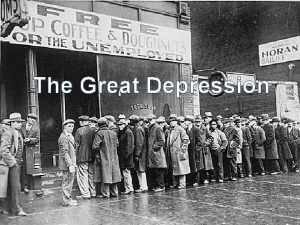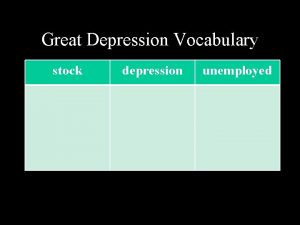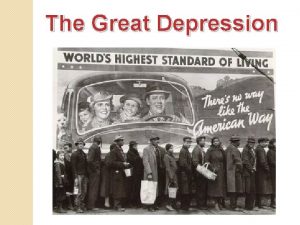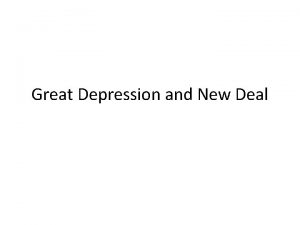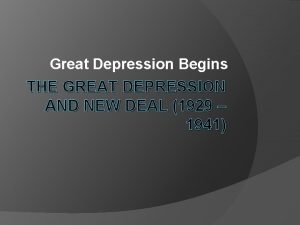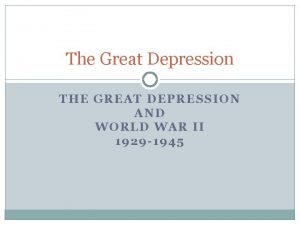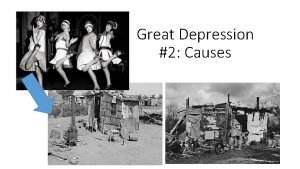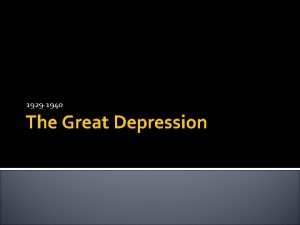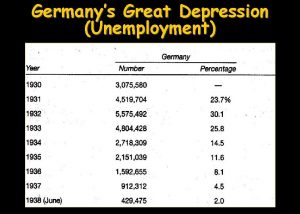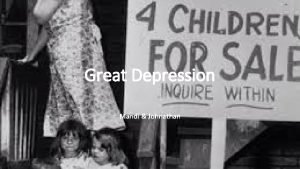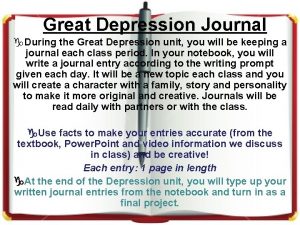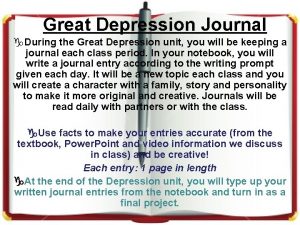Chapter 33 APUSH The Great Depression and the


































































- Slides: 66

Chapter 33 APUSH The Great Depression and the New Deal

The Election of 1932 Franklin Roosevelt Herbert Hoover v Believed that federal Believed government had a government should not try to fix responsibility to help people in people’s problems need and provide direct relief v He believed direct relief would v Believed capitalism and laissez destroy people’s self-respect. faire needed to be reformed v He believed it would create a big v Governmental involvement in government which would violate people’s lives was a good source laissez faire for those in need. v

• Democrat Franklin D. Roosevelt, beat the Republican, Republican Herbert Hoover, who was running for reelection. • FDR promised relief for the unemployed, help for farmers and a balanced budget. • Prohibition, Prohibition whether it should be repealed or not.

• FDR and Hoover at FDR’s inaugural • Americans believed FDR could get the country out of the depression and put people back to work……

• Democrats • FDR appealed to the common man because he was crippled • Eleanor became the eyes and ears for her husband • Promised to help the people through the Great Depression by direct governmental involvement

CARTOON 1932

• The Dust Bowl was an ecological and human disaster that took place in the southwestern Great Plains region, including Oklahoma, in the 1930's. • It was caused by misuse of land years of sustained drought. • Millions of hectares of farmland became useless, and hundreds of thousands of people were forced to leave their homes----many migrated to California. • As the land dried up, great clouds of dust and sand, carried by the wind, covered everything and the word "Dust Bowl" was coined.











CARTOON 1932 • Many Americans were unsure exactly what FDR meant with his New Deal. • Interests group were lining up to protect their self-interests in FDR’s New Deal.

CARTOON 1932

• One of the immediate concerns of FDR was to raise the self confidence of the people……. . • He had to get people back on their feet by putting them back to work……. .

chats • President Roosevelt began the “fireside chats” on a weekly basis as a way to reassure the American people. • His comforting voice, calming words, confidence in the country and the American people helped restore faith of the American people in democracy.

• Roosevelt’s 100 days was very successful…. FDR and Congress went to work providing for direct relief, recovery and reform. • From March of 1933 to June of 1933, Roosevelt sent 15 proposals to Congress and all 15 were adopted • Congress and President tried anything reasonable to overcome the Great Depression. 100 days

NEW DEAL CARTOON Govt. programs which provided direct relief to suffering Americans through govt. spending……… · · · Renew democracy Restore confidence in the banking Stimulate economy Put people back to work. Social Engineers Brain Trust Restore self confidence How? FDR’s 3 R’s ·Relief: ease suffering of the needy ·Recovery: begin economic growth ·Reform: help prevent future economic crises

Part of FDR’s New Deal……Agencies created by the US Govt. to bring about the 3 R’s……Relief, Recovery, and Reform

alphabet RELIEF: Ease Suffering of the Needy FERA / 1933 Federal Emergency Relief Act Distributed $500 million of direct aid to unemployed workers such as food, clothing and grants of money to cities.

alphabet RELIEF: Ease Suffering of the Needy WPA / 1933 to 1943 Works Progress Administration Employed 8. 5 million workers in construction and other jobs, but more importantly provided work in arts, theater, and literary projects.

• Works Progress Administration (WPA), the New Deals main relief agency. • People employed by the WPA at its peak was more than 3 million • 2, 500 hospitals • 5, 900 schools • 13, 000 playgrounds • 125, 000 public buildings




alphabet RELIEF: Ease Suffering of the Needy CCC / 1933 to 1942 Civilian Conservation Corps • Sent 3 million young men to work camps to build bridges, replant forests and other conservation tasks. • Develop job skills and improve environment. • Removed surplus of workers from cities, provided healthy conditions for boys, provided money for families.

• Created in April 1933. • Within 4 months, 1300 CCC camps were in operation. • 300, 000 men in 1933 between ages 18 and 25 • Signed up for 6 months and made $30. 00 a month. • 1933 and 1941 over 3, 000 men served in the CCC. • Goal: Keep teenage young men off the street and away from the job market. • Develop job skills and improve environment

Planted trees, built public parks, drained swamps to fight malaria, restocked rivers with fish, worked on flood control projects and a range of other work that helped to conserve the environment.




alphabet RELIEF: Ease Suffering of the Needy HOLC / 1933 Home Owners Loan Corporation Prevented mortgage foreclosures. US Govt. bought up mortgages and refinanced them so that homeowners could pay their mortgages.


RECOVERY: Begin Economic Growth NIRA / 1933 National Industrial Recovery Act • Created NRA to enforce codes of fair competition, minimum wages, and to permit collective bargaining of workers.

• Also called the National Recovery Act. • Helped businesses organize codes setting prices and minimum wage. • Put people back to work at decent jobs, wages and working conditions. • Businesses were not forced to join this. • Declared unconstitutional by the Supreme Court in 1935 because it violated laissez faire.



RECOVERY: Begin Economic Growth AAA / 1933 Agricultural Adjustment Act • Protected farmers from price drops and over production. . • US Govt. Paid farmers (subsidies) • not to grow crops, produce dairy products such as milk and butter or raise pigs and lambs. • Prevent another Dust Bowl, teach farmers methods of preventing soil erosion.

RECOVERY: Begin Economic Growth TVA / 1933 Tennessee Valley Authority • Federal government built a series of dams to prevent flooding and sold electricity. • First public competition with private power industries. alphabet


• Develop a poor section of the Southeast U. S. • Stimulate the economy and produce cheap electricity. • Control floods, planting new forests. • Bring this section into the 20 th century. · 94 percent of property owners and 98 percent of tenants did not have electricity. · 30 percent of property owners and 41 percent of tenants had no toilet facilities whatsoever

· 65 percent of property owners and 78 percent of tenants had to travel at least 300 yards to get their household water. · 8 percent of property owners and 3 percent of tenants owned radios (usually battery operated). · 39 percent of property owners and 23 percent of tenants had phonographs (including record players that were operated with a hand crank).

· 50 percent of property owners and 25 percent of tenants read newspapers. · 26 percent of property owners and 16 percent of tenants owned automobiles. · 7 percent of property owners and 4 percent of tenants owned trucks.



TVA MAP

TVA CRITICISM

REFORM: Prevent Another Depression FDIC / 1933 Federal Deposit Insurance Corporation Glass-Steagall Act created federally insured bank deposits ($5000 per investor at first) to prevent bank failures.

REFORM: Prevent Another Depression SEC / 1934 Securities and Exchange Commission Regulated stock market and restricted margin buying, and frauds.

The National Labor Relations Act ► The National Labor Relations Act § also called the Wagner Act § It guaranteed workers the right to organize unions without interference from employers and to bargain collectively. § The National Labor Relations Board (NLRB) which organized factory elections by secret to determine whether workers wanted a union. § The NLRB then certified successful unions. § The new law also set up a process whereby dissatisfied union members could take their complaints to binding arbitration, in which neutral party would listen to both sides and decide issues. § The NLRB was authorized to investigate the actions of employers and had the power to issue “cease

REFORM: Prevent Another Depression SSA / 1935 Social Security Act Response to critics (Dr. Townsend and Huey Long), it provided retirement pensions, unemployment insurance, aid to blind, deaf, disabled, and dependent children.

• One of the most important features of the New Deal • Established a retirement for persons over 65 funded by a tax on wages paid equally by employee and employer. • Old age insurance • Protect Americans who were unable to support themselves. • Unemployment compensation • Compensation to disabled workers and assistance to widows and children

Criticisms of New Deal ·US government and President too powerful ·Violated laissez faire ·Supreme Court declared NIRA and AAA unconstitutional ·Critics: ·Father Charles Coughlin ·Dr. Francis Townsend ·Al Smith ·Huey Long ·Deficit spending: Govt. spends $$$ to stimulate the economy and help people even if it means US Govt. goes into debt. ·Welfare state----Created a population of Americans who relied on the US Govt. to live

• A Roman Catholic priest. • Radio Priest in Detroit Michigan. • Criticized FDR in weekly radio program. • 10 million listeners. • Criticized FDR’s farm program • Believed an international conspiracy of bankers existed and FDR was influenced by them. • He called for the nationalization of banks and utilities. (US Govt. controls banks, Socialism) • Fascist; Anti-Semitic overtones.

• He wanted the government to help older citizens. • Retired California Physician. • Suggested a $200 per month pension for people over 60. Open jobs for the younger unemployed. • Spending all $200 would also be required to boost economic demand. • Townsend Clubs created all over the nation. • Influenced FDR’s creation of Social Security

Successes of New Deal AMERICANS IN 1939 WHO WANTED THE NEW DEAL TO CONTINUE WAS 55%…. . 37% REGARDED IT AS A BAD INFLUENCE AND WANTED A NEW PRESIDENT…………. . . ·Stimulated the economy ·Put people back to work…. ·Improved morale and self-confidence of the people ·US Govt’s. role changes and became directly involved in helping people ·WWII ended the Great Depression not FDR’s New Deal

25% to 40% of workers out of work Was able to lower it to 14%

LEFT No Govt Anarchy CENTER RIGHT Socialism Democrat Independent Republican Green Party Reform Communism Radical Liberal Moderate KKK Dictator Conservative Reactionary Fascist ·The New Deal walked a tightrope between the extreme positions of the left and right ·Critics would claim it was unconstitutional, socialism, antilaissez faire and went too far to the left. ·Others would claim the New Deal didn’t go far enough to the left……

• Supreme Court was striking down New Deal legislation. • Roosevelt proposed a bill to allow the president to name a new federal judge for each who did not retire by age 70 and 1/2. • 6 justices over age limit. • Would have increased the number of justices from 9 to 15, giving FDR a majority of his own appointees on the court. • The court-packing bill was not passed by Congress.

Supreme Court Congressional opposition was beginning to grow; many of his laws, including the WPA, were taking a long time to get passed and met resistance. ► Schechter v. United States § The Schechter brothers had a poultry business in Brooklyn. § They had been convicted in 1933 of violating the NIRA’s Live Poultry Code; they had sold diseased chickens and violated the code’s wage-and-hour provisions. § Known as the “sick chicken case. ” § The Supreme Court said that the Constitution did not allow the Congress to lend its powers to the executive; the NIRA was unconstitutional. § This suggested that the Supreme Court would make similar decisions in regards to the New Deal.

The Committee for Industrial Organization The United Mine Workers union began to work with other unions to organize workers in industries where unions did not exist. ► To do this, they formed the CIO ► They began with automobile and steel industries—two of the largest industries ► In late December 1936, General Motors launched a sitdown strike do to the first sit-down strike due to the demotion of two workers ► Violence broke out in Flint when police launched a tear gas assault on one of the smaller plants. ► Afterward, GM broke down and recognized the CIO union, United Auto Workers as its employees sole bargaining organization. ► This led to others using the sit-down strike as a method in other industries. ►
 Chapter 33 the great depression and the new deal
Chapter 33 the great depression and the new deal Chapter 14 the great depression begins vocabulary
Chapter 14 the great depression begins vocabulary New woman
New woman Chapter 22 the great depression begins
Chapter 22 the great depression begins Compare and contrast fdr and hoover
Compare and contrast fdr and hoover Great depression and new deal vocabulary
Great depression and new deal vocabulary Hardship and suffering during the depression
Hardship and suffering during the depression Pros and cons of the great depression
Pros and cons of the great depression What is the main idea of this cartoon?
What is the main idea of this cartoon? Second great awakening apush chapter 15
Second great awakening apush chapter 15 Rarig great depression
Rarig great depression Great depression
Great depression The ingenious quarterback
The ingenious quarterback Foreclosure great depression
Foreclosure great depression Five effects of the great depression
Five effects of the great depression Five effects of the great depression
Five effects of the great depression How did the great depression impact the world
How did the great depression impact the world Dawes plan
Dawes plan Bud not buddy great depression
Bud not buddy great depression Pantoum of the great depression analysis
Pantoum of the great depression analysis Summary of great depression
Summary of great depression Cpi during the great depression
Cpi during the great depression Okies great depression
Okies great depression The great depression leq
The great depression leq Five effects of the great depression
Five effects of the great depression How did the great depression affect daily life
How did the great depression affect daily life Timeline of the great depression
Timeline of the great depression Great depression causes
Great depression causes Brief summary of the great depression
Brief summary of the great depression Hoovervilles
Hoovervilles Birth rate during the great depression
Birth rate during the great depression Overspeculation great depression
Overspeculation great depression Great depression vocab
Great depression vocab Great depression
Great depression Http://www.history.com/topics/great-depression
Http://www.history.com/topics/great-depression Great depression
Great depression Hawley-smoot tariff great depression
Hawley-smoot tariff great depression Stock market cartoons
Stock market cartoons Lesson 3 effects of the great depression
Lesson 3 effects of the great depression Hoover v. fdr responses to the great depression
Hoover v. fdr responses to the great depression Laissez faire great depression
Laissez faire great depression Laissez faire great depression
Laissez faire great depression Great depression acrostic
Great depression acrostic Hoovervilles great depression
Hoovervilles great depression What is the message of this political cartoon
What is the message of this political cartoon Great depression jeopardy
Great depression jeopardy Great depression
Great depression Great depression webquest
Great depression webquest James zwerg
James zwerg Hoover's response to the great depression
Hoover's response to the great depression Great depression
Great depression What was hoover's response to the great depression
What was hoover's response to the great depression Great depression
Great depression Great depression
Great depression Great depression drawing
Great depression drawing High tariffs great depression
High tariffs great depression Great depression photographer
Great depression photographer Hoover's response to the great depression
Hoover's response to the great depression Great depression
Great depression Hoovers poor farm tobacco fund
Hoovers poor farm tobacco fund What were the long term causes of the great depression
What were the long term causes of the great depression The great depression outline
The great depression outline Great depression journal entry
Great depression journal entry Franklin d. roosevelt
Franklin d. roosevelt What does aaa stand for great depression
What does aaa stand for great depression During the great depression there were many wanderers
During the great depression there were many wanderers What was the great depression
What was the great depression
